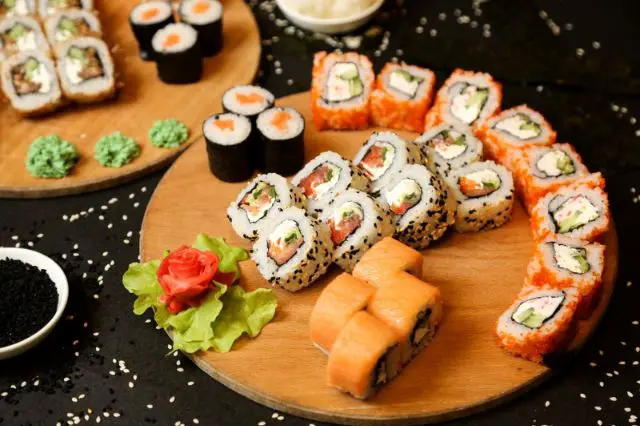Food
10 New Snacks to Try Out This Year


When your stomach begins to growl between meals, this might mean that it is time for a snack. Snacking can be part of a healthy balanced diet depending on your choice of snack and frequency of snacking.
Cookies, cakes, and potato chips are common choices but while they are tasty, convenient foods, they aren’t always the healthiest option. Why not experiment with some new snacks in 2023 and introduce some new flavors and textures to your taste bud?
Here are a few snacks to try out this year:
Freeze dried candies
Candy sweets are a common choice of snack, but have you tried flavored jerky? There are all kinds of jerky in sweet and savory flavors like this Lime and Garlic Mojo Jerky. Jerky is a good source of protein and convenient for hikers and those camping.
Kale chips
A source of fiber, vitamin A, vitamin B, vitamin C and potassium, kale chips can make a healthier and lower calorie replacement for potato chips. You can make these chips at home or buy them pre-packaged in stores.
Chia pudding
Chia pudding is made from chia seeds and milk, these puddings are a great source of omega 3 fatty acids, protein, antioxidants, and fiber. You can add many different fruits or seeds to your chia pudding too.
Plant milks such as coconut, almond or soya make great non-dairy alternatives to cow’s milk too. Chia puddings can be made at home and stored in jars in the fridge, ready for a snack, breakfast, or dessert.
Empanadas
Empanadas are a fried or baked pastry shaped that come with a variety of fillings, including meat options like chicken and shredded beef and vegetarian options such as potato, mushroom, and cheese.
For those with a sweet tooth, chocolate and cream, Nutella and cream cheese empanada desserts can make a tasty treat.
Empanadas have roots in South America and Spain but have become increasingly popular in the US in recent years. If you haven’t tried one yet, you should consider an empanada for your next indulgent snack.
Plantain chips
Like kale chips, baked plantain chips can make a healthier snack option than classic potato chips. Plantain chips come in a wide variety of flavors, including sea salt and chili.
They are also an easy snack for those on a gluten-free diet and are generally easy find in large food stores. You can even make plantain chips at home in the oven with sliced plantain, oil and seasonings.
Coxinhas
Coxinhas are a delicious Brazilian treat and can be described as teardrop-shaped croquettes that come with a variety of fillings. Shredded chicken is a common choice but cheese coxinhas are a great vegetarian alternative.
These are served everywhere, bars, cafes, food stores and restaurants in many Latin American countries. You can also find recipes online and try making your own coxinhas at home.
Arepas
Also popular in South America are arepas, these snacks are made from cornmeal and are great for any time of the day. They can be stuffed with meats, egg, cheese, beans, pumpkin or whatever else you fancy.
They are fairly easy to make at home or are served in many restaurants as light bites or meals. Vegan and gluten-free versions are also available.
Mixed nuts
Need a quick snack that will provide you energy and fill you up? Nuts such as cashews, almonds, walnuts, pistachios, and pine nuts can all be a good source of protein and fiber.
Greek yogurt
Greek yogurt is ideal as a filling and healthy post-workout snack and will provide a boost of calcium.
British Scones
Served with jam and cream and paired with a cup of tea, this British staple is an indulgent and tasty, sweet treat.


Food
How to Make Homemade Sushi Like a Chef?


Sushi has captivated dining tables around the world, winning over palates with its subtle balance of flavors and artistic presentation. Beyond their refined appearance, sushi embodies a rich culinary tradition where every detail matters, from the selection of ingredients to the preparation technique.
Have you ever wondered how to make homemade sushi like a chef? This art, though daunting at first, is accessible to anyone with a bit of practice and patience. The key lies in choosing quality ingredients and mastering a few essential techniques.
Through this guide, we’ll see how to transform your kitchen into a true sushi bar, impressing your friends and family with your creations.
What are the key ingredients?
The foundation of any good sushi rests on the quality of its components. Sushi riceis the fundamental element; opt for short or medium-grain rice specially designed for sushi, which, once cooked, presents the ideal sticky texture.
The secret to perfect rice lies in its washing and cooking: rinse it in cold water until the water runs clear to remove excess starch, then cook it with the recommended amount of water.
Fresh fish is just as crucial. For sushi, prefer fish with firm and flavorful flesh, such as salmon or tuna, ensuring their impeccable freshness.
Visit a trusted fishmonger, ideally a specialist in seafood intended for raw consumption, and clearly express your intention to prepare sushi.
Other ingredients complete the flavor palette: creamy avocado, crunchy cucumber, nori sheets (dried seaweed), spicy wasabi, soy sauce for dipping, and pickled ginger to cleanse the palate between bites.
Each plays its role in the harmony of the sushi, adding texture and depth.
What equipment do you need?
Simplicity is at the heart of Japanese cuisine, and this is reflected in the equipment needed to prepare sushi. A makisu, or bamboo mat, is indispensable for rolling makis with precision.
A sharp knife is essential, not only for finely slicing the fish but also for cutting the sushi rolls cleanly.
Although not essential, a rice cooker can simplify the preparation of sushi rice, ensuring perfect cooking and temperature.
How to perfectly prepare sushi rice?
The success of your homemade sushi largely depends on the quality of your rice. How to achieve that perfect vinegared rice, both sticky and shiny, which forms the base of all good sushi?
It all starts with choosing the right type of rice. Opt for quality sushi rice, often labeled as “sushi rice” or “Japanese rice”.
This rice is stickier than other varieties, which is essential for making sushi.
The first step is to wash the rice. Place it in a bowl and rinse it with cold water, gently stirring with your hands, until the water becomes clear. This step removes excess starch and ensures the rice won’t be too sticky. Then, drain it well and let it rest in the strainer for about 30 minutes.
For cooking, use one measure of water for one measure of rice. If you have a rice cooker, now is the time to use it. Otherwise, a pot with a lid will do.
Cook until the water is completely absorbed, then remove from heat and let the rice sit covered for 10 minutes.
The final step is to prepare the sushi vinegar. Mix rice vinegar with sugar and salt. Proportions vary according to taste, but a good base is 3 tablespoons of vinegar for 2 tablespoons of sugar and 1 teaspoon of salt for 500g of rice.
Warm the mixture slightly to dissolve the sugar and salt, without boiling it. Then pour the warm vinegar over the rice and gently mix with a wooden spatula, fanning the rice to cool it quickly.
Your sushi rice is ready when it reaches room temperature.
What are the secrets to preparing sushi ingredients like a chef?
Freshness is your watchword, especially when it comes to fish. For sushi, choose fresh fish, ideally bought the same day from a trusted fishmonger.
Salmon and tuna are popular choices, but don’t hesitate to experiment with other types of fish or seafood according to your tastes.
The cut of the fish is crucial. Use a sharp knife and slice the fish into thin, diagonal slices to achieve the ideal texture and thickness for nigiris or sashimis.
For makis, thinner and longer strips will be necessary.
Vegetables should also be fresh and crunchy. Wash and dry cucumbers, avocados, and any other vegetables you wish to use thoroughly. Cut them into thin sticks to facilitate the rolling of makis.
How to assemble sushi for a restaurant-quality result?
Let’s start with makis, those sushi rolls wrapped in a nori sheet. Place a nori sheet on a bamboo mat. Spread an even, thin layer of rice over 3/4 of the sheet, leaving a space at the edge to close the roll.
In the center of the rice, arrange a line of your chosen ingredients. Use the mat to roll the sushi firmly, starting from the edge closest to you. Press lightly to ensure the roll’s cohesion, then use a wet knife to cut the roll into pieces.
For nigiris, moisten your hands slightly to prevent the rice from sticking. Take a small amount of rice and form an oblong ball. Apply a thin layer of wasabi on the fish, then place it on the rice. Press gently so the fish adheres to the rice.
Sashimis, on the other hand, do not require rice. Simply serve the fresh fish slices on a plate, accompanied by soy sauce, wasabi, and pickled ginger for tasting.
How to present and enjoy sushi?
After carefully preparing your sushi, the next step is to present them in a way that brings out their beauty and to properly enjoy their flavor.
The presentation of sushi is almost as important as their taste. Arrange them on a platter or plate attractively, alternating colors and shapes to captivate the eye.
Don’t forget to include a small bowl of soy sauce, a mound of wasabi, and a few slices of pickled ginger on the side to complete the experience.
As for tasting, there are a few unwritten rules that can enrich your experience. Start with the lighter sushis before moving on to stronger flavors, so as not to overwhelm your palate.
What are the secrets to successful homemade sushi?
First, patience and precision are key. Take your time to prepare the rice and cut the ingredients carefully. A good, sharp knife makes all the difference in achieving perfect fish slices.
Another tip is to keep your hands slightly moist when handling the rice, to prevent it from sticking.
Finally, don’t overload your rolls with too many ingredients, so that each flavor can shine.
What are the common mistakes to avoid?
One of the most frequent errors is not washing the rice properly, which can affect its texture and taste. Another is using fish that is not fresh enough or of sushi quality.
Finally, avoid overcooking the rice or misjudging the sushi vinegar, as this can ruin the delicate balance of flavors.
How to customize your sushi?
Don’t limit yourself to traditional recipes. Sushi offers a culinary playground to express your creativity. Try vegetarian sushi using seasonal vegetables, or dare to combine bold flavors like teriyaki chicken or Peking duck.
Fusion sushi, mixing elements from different cuisines, can also offer surprising and delicious flavors. The important thing is to have fun and experiment with different ingredients to find what pleases you most.
Conclusion
Making homemade sushi like a chef is within everyone’s reach, as long as you follow some basic principles in terms of ingredient selection, preparation, and assembly. By keeping in mind the chef’s advice and avoiding common mistakes, you can create sushi that will delight both your eyes and your palate.
-



 Quotes4 years ago
Quotes4 years ago125 Inspirational Car Quotes and Captions to Celebrate Your New Car
-



 Growth4 years ago
Growth4 years ago188 Deep Hurt Quotes with Images
-



 Quotes3 years ago
Quotes3 years ago148 Romantic Love Quotes for Her from the Heart
-



 Quotes3 years ago
Quotes3 years ago185 Cute Boyfriend Quotes for the Guy You Love
-



 Quotes3 years ago
Quotes3 years ago141 Best Heart Touching Quotes about Love, Life, and Friendship
-



 Quotes3 years ago
Quotes3 years ago134 Time Flies Quotes for the Unforgettable Moments
-



 Quotes3 years ago
Quotes3 years ago122 Inspirational Kite Quotes That’ll Make You Wanna Fly Right Now
-



 Quotes4 years ago
Quotes4 years ago101 Powerful Black Women Quotes to Empower You






